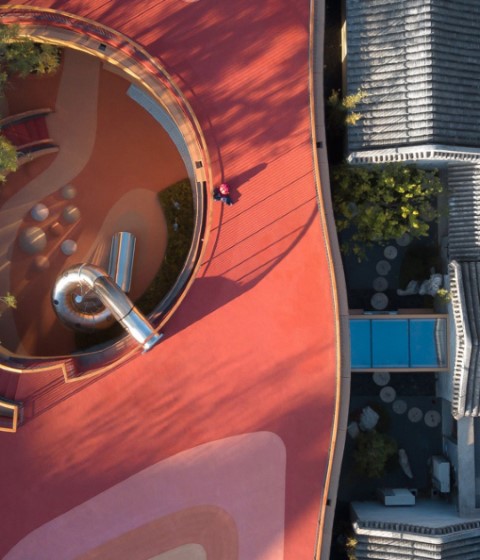The nursery made by Birk Heilmeyer und Frenzel Architekten, rests on an old anti-aircraft bunker, which even without having been intervened, was an important determining factor at the time of implementing the project, limiting the possible structural systems to be used. This, in addition, is added to the rigorous restrictions of the local building code causing, between the two, a large part of the spatial characteristics of the building would be determined a priori (dimensions, orientations, materials, among others).
The work follows a clear project line started with the work carried out by the studio between 2009 and 2014 for the design of a modular design system for childcare facilities for the city of Frankfurt.
On the one hand, like this system, the work has two levels made entirely with a lightweight prefabricated wood structure (a situation also favoured by the pre-existing shelter on which the project is built). To this are added two other vital aspects for the study, passive air conditioning and connection with outdoor spaces. To this end, the building was equipped with skylights on the roof and large openings with sunlight control provided, in part, by the setbacks of the carpentry and the covered circulations that surround the building. Concerning the exterior spaces, the proposal tries to balance its relationship with the outside, not only in perceptual terms but also practicable, and for this reason, two cores of attached stairs were arranged, which break the purity of the volume and allow reaching the garden from any part of the program.
Description of project by Birk Heilmeyer und Frenzel Architekten
In the east of Stuttgart, the four-group daycare center “Kita Parkstraße” was completed according to plans by Birk Heilmeyer and Frenzel Architects and handed over to the users. The wooden structure was erected on an underground bunker. Shortly before the building was handed over, the day care center received a Hugo Häring award from the BDA.
The property of the KiTa Parkstrasse is located in the vicinity of the Berg Cultural Park in the east of Stuttgart. The new two-storey building of the fourgroup nursery school is part of the green corridor with historic trees on the site of the previous building. The positioning, building dimensions, construction and materials of the building are based on the special characteristics of the premises: The local building code specifies a building depth of twelve metres. Its position and orientation result from the construction line and the terrain sloping from west to east. The foundation on an existing underground bunker makes a lightweight timber construction the only alternative. The main entrance is located on the north side and is easy to distinguish within the façade. The foyer, which also serves as a parents’ meeting place, runs from north to south and opens towards the garden. From here the multipurpose room is accessed, and a corridor leads to the group areas in the south and the adjoining rooms in the north. All common rooms on the upper floor feature a loggia in front of them. Two external staircases, which stand out vividly against the building structure, lead directly from the upper floor down to the garden with open-air play areas.
The clear segmentation of the building into a group space and an ancillary room area is reflected in the design of the façades and the shape of the roof. Skylights in the roof above the corridor enhance this impression and allow for good lighting and ventilation of the building. Due to the internal organisation of the building, the sanitary and ventilation installations can be restricted to the ancillary room partition. This means that the room heights in the common rooms can be increased, whilst the amount of ceiling suspensions is reduced. The nursery is designed as a structural timber construction with a high degree of prefabrication. The lower weight of the timber construction allows the building to be erected on the air-raid shelter below. The rising construction of the nursery consists of flat timber elements. The exterior walls benefit from all the advantages of a timber frame construction with ventilated facade cladding. Through the red colour of the vertical timber cladding the building stands out against the green of the surrounding park.
Shortly after the construction was completed, the day-care center received a Hugo Häring Award 2020 from the Association of German Architects (BDA).
“It is the simplicity that makes this building so powerful. Its position in the urban fabric. Its clear form, organisation, and structure. The reduction to few materials. The use of two striking colours. And it is precisely the red of the shell that creates the effect of the building as if it were an apparition in the park, raising it from pure functionality to a poetic level. Strangely aloof and at the same time very present. The contrasting green on the inside, which conjures up the colour of the leaves on the floor like a reflection on water, creates a strong connection between inside and outside. This is a decidedly successful building, planned down to the last detail - consistently simple, but never simplistic“.
Judges the jury



































